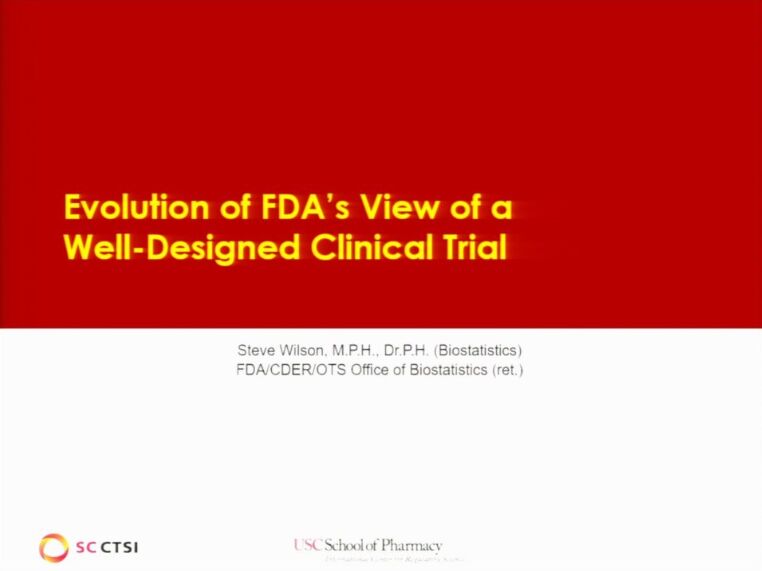- Presentation Title: Evolution of FDA’s View of a Well-Designed Clinical Trial
- At the time of presentation, Wilson had recently retired from working in the FDA.
- Presented by Steven Wilson, MPH, DrPH
- Acronymese: A Pretest
- Truth-In-Advertising
- Will discuss about Regulatory decisions (Risk-Benefit…based Safety and Efficacy)
- Evolution. A Definition
- “a process of continuous change” from lower/simpler/worse to higher/more complex/better state
- Outline
- Science: Transparent/Independently Reproducible
- Science, Statistics, and Experimental Design
- Research - Answer questions to come up with more questions
- Science/Data-Based Decision-Making
- Wilson started as biochemist
- Some Characteristics of Good Science
- Empirical, Objective, Replicable, Systematic, Provisional
- Top 10 Qualities of Good Academic Research
- Regulatory Science & Decision Making: The Level Playing Field
- FDA Approval creates that the impression that FDA conducted these trials (not true) and that the product is good
- FDA works to make sure that industry “plays” by the rules
- Making decisions with quality data and abiding laws & regulations
- The New Drug Development Process: Steps from Test Tube to New Drug Application Review
- Commercial Confidentiality Concerns
- Money/Financial Interest
- FDA White Oak (Maryland) Campus
- Food and Drug Administration (FDA) Departments
- Center for Drug Evaluation and Research (CDER)
- The Medical Products Piece of FDA’s Current Mission
- Regulatory “Communication Tools”
- Primary vs. Additional
- Primary Tools: Acts, Regulations, CFR, Legal Precedents, Guidance
- Additional Tools: Advisory Committees, Regulatory Decisions, Agency Initiatives, Regulatory Science/Research
- Primary vs. Additional
- Acts/Regulation/Guidance: Regulatory “Communication Tools”
- FDA: Intimidating View to a “We Are to Help You” Impression
- Regulation
- Good Guidance Practices Regulation
- The Courts-Legal Precedents
- Ex. Clinical trials need to produce and include more than statistical evidence but also therapeutic significance
- Guidance
- Guidance documents represent FDA’s current thinking of a particular subject
- Not enforceable
- Alterative approach is available but needs necessary rationale in the form of satisfying applicable statues, regulations, or both
- FDA has become more complex because there is more being checked/done and because drugs are increasingly becoming complex
- Good Guidance Practices Regulation
- Shows FDA how to guide industry via. Writing/legal language
- The Process: Draft Regulations & Guidance
- Public comment period
- Regulation- FDA must address all comments but for Guidance, FDA uses comments as advice
- Global Guidance: The International Conference on Harmonisation (ICH)
- The International Council for Harmonisation of Technical Requirements for Pharmaceuticals for Human Use ICH
- Name Change from The International Conference on Harmonisation
- Important ICH Guidelines pertaining to Clinical Trials: E3, E5, E6, E6, E9, E10, E17
- We had to discuss the impact of how clinical trials can produce different data in different countries.
- FDA Regulations
- All Guidances are available on FDA website
- FDAAA & PDUFA IV
- Must be reviewed every 5 years
- Acts/Regulation/Guidance: Are You (Ever) Ready?
- Some History of FDA and Clinical Trials
- FDA History: Patent Medicine
- In the past (prior to the creation of the FDA), the market had drugs/medicines that relieved pain without any regulation
- FDA History: The “Poison Squad”
- FDA History: The Law – Getting to Clinical Trials
- 1906: Food and Drugs Act
- Banned misbranding and adulterated products
- 1938: The Federal Food, Drug, and Cosmetic (FDC)
- 1962: Thalidomide & Kefauver-Harris Drug Amendments
- Thalidomide: Sleeping pill
- Lack of regulation of how drug being distributed and tested prompted these amendments
- 1906: Food and Drugs Act
- Francis Kelsey: FDA Reviewer
- Post 1962 Drug Amendments (1)
- Conflict of interest concerns among FDA and agency/sponsor
- FDA is not allowed to say one drug is better than another (no endorsement)
- Post 1962 Drug Amendments (2)
- New US drugs must be investigated under an IND (Investigational New Drug Application
- Post 1962 Drug Amendments (3)
- A lot of drugs being approved between 1938 and 1962 but with no proof efficacy so FDA had to go back and review the data of those drugs
- Clinical Trial: A Definition
- Clinical Trials in the 20th Century (1)
- Systematic schemes for treatment assignment
- Clinical Trials in the 20th Century (2)
- Treatment assignment by randomization
- Clinical Trials in the 20th Century (3)
- Multicenter trials- multiple investigators at different sites, following a common protocol
- Why Evidence from Clinical Trials?
- Best way to determine if intervention has proposed effect and see the risks
- An individual’s reaction can still be different from the study
- Example: The Cardiac Arrhythmia Suppression Trial (CAST)
- Drug Approval: Effectiveness
- Adequate and well-controlled multiples studies to approve effectiveness
- Substantial Evidence- Adequate and Well-Controlled Studies
- Drug Approval: Effectiveness
- CFR: 314.126 Adequate and well-controlled studies
- Providing Clinical Evidence…
- CFR mentioned previously became the Scientific Basis for the Legal Standard
- “Gold Standard” for Approval of an NDA/BLA
- Establishing a standard for uniformity (rather than a value that was brought by scientific data)
- Regulatory Science: The Confirmatory Trial
- A confirmatory trial is an adequately controlled trial in which the hypotheses are stated in advance and evaluated
- Such trials can be expensive and resource-costly
- Good documentation is a “simple” way to show this type of trial
- Evolving: The Evidence Document
- FDAMA (1997) and Clinical Investigations
- Sec. 115. Clinical Investigations provision was clarified, and law was changed
- Note to Self: The “History of Clinical Investigations” Is Still Happening
- Clinical Trials Have Evolved Into—Big, Complex, Expensive Experiments
- NDA Submission Regulations
- Guideline for the Format and Content of the Clinical and Statistical Sections of New Drug Applications
- Prior to Electronic Submission
- Paper Review of an NDA
- A lot of physical papers/notebooks and documentations on shelves
- Ex. The NDA for Prozac was 1000 pages.
- Now, everything is done electronically.
- 21st Century Review of Drugs and Biologics
- Some Communication with Sponsors to Facilitate drug development & Review (Pre-PDUFA)
- Before, those who finished Phase 2 and do not have a big enough population for Phase 3 came to talk with the FDA and FDA decided based on the severity of disease that the drug is created for, benefits and consequences of continuing the drug, and the difficulty on studying the disease
- Some Additional PDUFA Directed Communication During Review
- More Communication During Development of Drugs & Biologics
- Fast Track, Breakthrough Therapy, Accelerated Approval, Priority Review
- Ex. For oncology, FDA professionals would meet with investigators regularly
- Rare Disease Program
- For conducting clinical trials with small, specific populations
- Working with Industry/Investigators
- FDA has become increasingly involved in the development of drugs
- Dr. Woodcock’s Critical Path Initiative: Starting Point – 76 Points
- Diseases have different endpoints, which today’s FDA is paying closer attention to
- China is becoming more increasingly involved in clinical trial as well
- These Are Exciting Times!
- Oncology Center for Excellence
- CDISC Data Standards
- Free to everyone and online
- NIH FDA Protocol Template
- Used for phase 2 and 3 and includes all the guidances
- PDUFA VI: Complex Design Workshop
- Possibility of special attention for sharing intellectual property and enriching the clinical trials of certain field/specific ailment
- A Few Closing Words
- Field of Clinical trials complex and evolving
- Reg Sci is diff/confidential
- Acts and regulations responding to Public Health but needs supporting change
- Collaboration is essential
- FDA does not have all skills and talent to do it alone
- Exciting/Interesting times
- Direct to Consumer Advertising (1)
- Only 2 countries in the world can directly advertise to potential consumers that their product help their specific ailment
- Direct to Consumer Advertising (2)
- Attracting youth and advertisements are influential
Regulatory Science Symposium: Regulatory Aspects of Clinical Trial Design Session 2: Evolution of FDA’s View of a Well-Designed Clinical Trial (2018)
In this session, we will discuss how to conduct an effective clinical trial from the perspective of the FDA.
Research & Study Design
Regulatory & Quality Sciences
Steven Wilson, DrPH
Center for Drug Evaluation and Research-Retired 2017
Course Syllabus/Topics
Ackowledgement
Accompanying text created by Annie Ly | Undergraduate Research Associate and Provost's First Generation Research Fellow | lyannie@usc.edu

